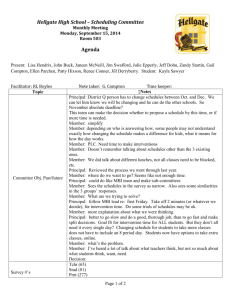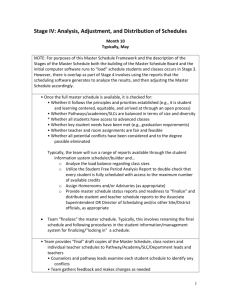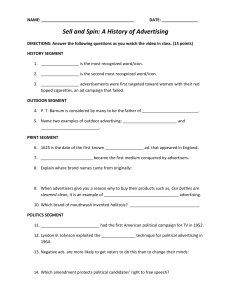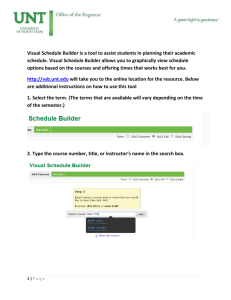Media Models for the Industrial Goods Advertiser—A Do-it
advertisement
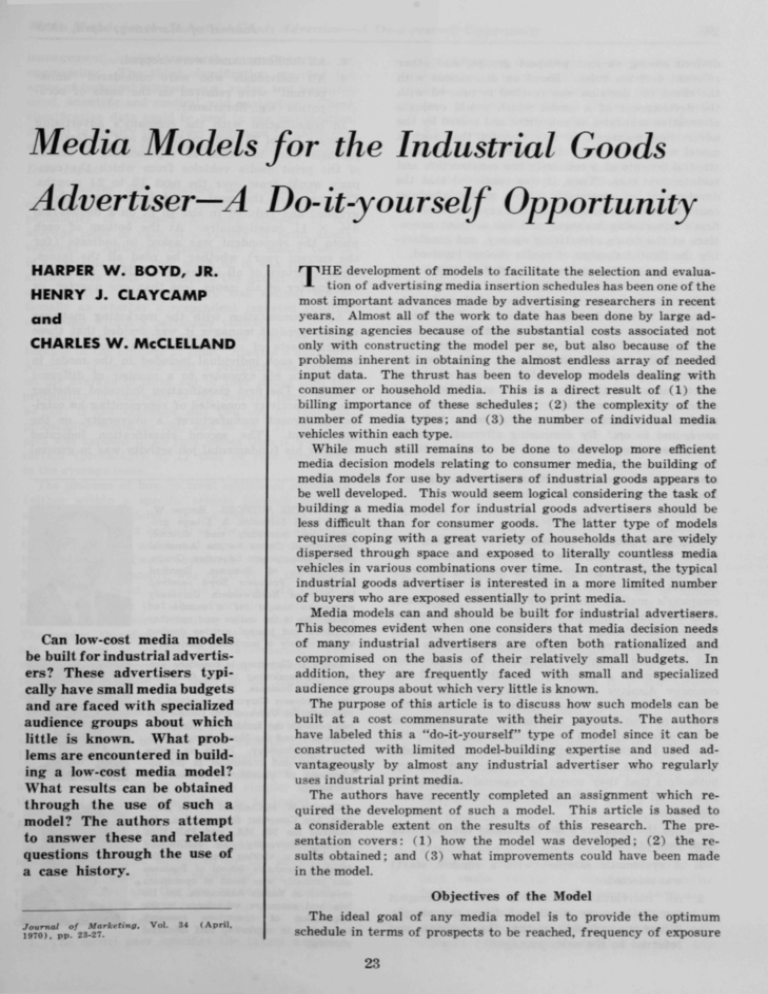
Media Models for the Industrial Goods Advertiser—A Do-it-yourself Opportunity HARPER W. BOYD, JR. HENRY J. CLAYCAMP and CHARLES w . MCCLELLAND Can low-cost media models be built for industrial advertisers? These advertisers typically have small media budgets and are faced with specialized audience groups about which little is known. What problems are encountered in building a low-cost media model? What results can be obtained through the use of such a model? The authors attempt to answer these and related questions through the use of a case history. n P H E development of models to facilitate the selection and evalua-•- tion of advertising media insertion .schedules has been one of the most important advances made by advertising researchers in recent years. Almost all of the work to date has been done by large advertising agencies because of the substantial costs associated not only with constructing the model per se, but also because of the problems inherent in obtaining the almost endless array of needed input data. The thrust has been to develop models dealing with consumer or household media. This is a direct result of (1) the billing importance of these schedules; (2) the complexity of the number of media types; and (3) the number of individual media vehicles within each type. While much still remains to be done to develop more efficient media decision models relating to consumer media, the building of media models for use by advertisers of industrial goods appears to be well developed. This would seem logical considering the task of building a media model for industrial goods advertisers should be less difficult than for consumer goods. The latter type of models requires coping with a great variety of households that are widely dispersed through space and exposed to literally countless media vehicles in various combinations over time. In contrast, the typical industrial goods advertiser is interested in a more limited number of buyers who are exposed essentially to print media. Media models can and should be built for industrial advertisers. This becomes evident when one considers that media decision needs of many industrial advertisers are often both rationalized and compromised on the basis of their relatively small budgets. In addition, they are frequently faced with small and specialized audience groups about which very little is known. The purpose of this article is to discuss how such models can be built at a cost commensurate with their payouts. The authors have labeled this a "do-it-yourself" type of model since it can be constructed with limited model-building expertise and used advantageously by almost any industrial advertiser who regularly uses industrial print media. The authors have recently completed an assignment which required the development of such a model. This article is based to a considerable extent on the results of this research. The presentation covers: (1) how the model was developed; (2) the results obtained; and (3) what improvements could have been made in the model. Objectives of the Model Journal of Marketing. Vol. 34 (April. 1970). pp. 23-27. The ideal goal of any media model is to provide the optimum schedule in terms of prospects to be reached, frequency of exposure 23 24 desired among various prospect groups, and other relevant decision rules. Based on discussions with the client the decision was reached to proceed with the development of a model which would evaluate altemative schedules as submitted and costed by the advertising manager. It was thought that such a model would have high utility and would yield substantial benefits at a relatively low construction and maintenance cost. Thus, it was concluded that the development of reasonably viable media schedules could be obtained considering the experience of the firm's advertising manager and the account executives at the firm's advertising agency, and considering the limited number of media choices involved. More specifically, the model (called MISER) bad as its objective among predetermined audience segments: 1) the production of a weighted readership score and 2) a readership distribution. The former yields a score which is based essentially on reach and frequency of exposure within time periods. The latter consists of two distributions. The first distribution reports the percentage of readers exposed exactly once, exactly twice, and so on. The second distribution is cumulative; that is, it reports the number of readers exposed once or more, twice or more, and so on. By comparing alternative media schedules designed to apply to a specific audience the user can decide which schedule is better given his objectives for the particular advertising program in question and the costs involved. Case Study The first problem encountered in building the model was the identification of members of the relevant audience groups for the company's line of products. This was accomplished by using the company's mailing list which included the name, title, and company affiliation of individuals recommended periodically by the salesforce to receive company literature. It also included all those who had requested technical literature, visited the company, attended a company workshop, visited the company displays at trade shows, or sent in an enquiry. This list was assumed to contain the names of individuals associated with companies which accounted for a very substantial part of the potential for the products involved. If the media habits of those individuals were known it was hypothesized that they would be reasonably representative of all buying infJnentials within all prospective companies. To use the company's list effectively the following steps were taken: 1. A systematic sample (with a random start) was selected. 2. All individuals associated with nonprospect companies were eliminated from the sample. Where any doubt existed, the decision was referred to the sales manager. Journal oj Marketing, April, 1970 3. All duplicate names were dropped. 4. All individuals who were considered "unimportant" were removed on the basis of occupation (e.g., librarians). In consultation with the company's advertising agency a list of 28 trade magazines and professional journals were identified as representing a census of the print media vehicles from which the company would draiv over the next 12 to 24 months. The covers of the most recent issues were photographed and reduced in size to fit on a double-fold 8^/2 X 11 questionnaire. At the bottom of each photo the respondent was asked to indicate (for the current year) whether he read all the issues, three quarters of all issues, one half of all issues, one quarter of all issues, less than one quarter, or none. After consultation with the marketing manager and his product manager it was decided that three different sets of classification data should be obtained on each individual included in the model in addition to his exposure to a number of different vehicles. The first classification indicated whether his basic activity consisted of representing an original equipment manufacturer, a university, or the government. The second classification indicated whether his fundamental job activity was in general • ABOUT THE AUTHORS. Harper W. Boyd. Jr. is Sebastian S. Kresge prolessor oi marketing and director. International Center ior the Advancement oi Management Education. Graduate School oi Business. Stcmiord University. Proiessor Boyd received his PhD at Northwestern University where he taught ior a numbei oi years. He is the author and coauthor oi books and journal articles dealing with a variety oi marketing subjects. Henry J. Claycamp is associate proiessor oi marketing in the Graduate School oi Business, Staniord University. Proiessor Claycamp received his PhD from the University oi Illinois and has been on the iaculties oi Washburn University and the Massachusetts Institute oi Technology. He is an active researcher and consultant in the applications oi quantitative methods in marketing. Charles W. McClelland is vice president. Lex Computer Systems. Inc. He received his BS, MA. and PhD irom Staniord University. Dr. McClelland has been a visiting lecturer at the Staniord Graduate School oi Business and iormerly was head oi operations research at Varian Associates, Inc. He has had extensive experience in the application oi operations research techniques in marketing and iinancial planning. Media Models jor the Industrial Goods Advertiser—A Do-it-yourselj Opportunity management, applied research, manufacturing, or engineering. The third classification specified his areas of technical interest—e.g., radar, test measurement, scientific and medical, and navigation. These classification data could be used in any combination desired to specify the target audiences to which one or more schedules would be submitted for evaluation. Data Inputs The survey data obtained were collapsed into essentially the following question, "What is the probability of prospect X being exposed to the average issue of each of a variety of print media vehicles?" Although exposure to a media vehicle is a variable (e.g., how much of it was read?) no attempt was made to measure the extent or degree of exposure. Thus, exposure was defined operationally as whether a respondent reported reading something within a particular vehicle. The probability statement comes into the model because of the problem of time. Assume a quarterly journal. If one knew that a prospect was exposed on the average to three out of four issues then the probability of exposure to the average issue would be .75; if the exposure was two out of four the probability would be .50; and so on. If the prospect was exposed to all four issues then it would be certain (probability of 1) that he read something in the average issue. The problem of how to treat additional exposures (either within a specific vehicle through time or among media vehicles) is not easily solved. The problem is complex because of the need to ascertain the effect of each additional exposure given certain time intervals between exposures. In the case at hand the first exposure was rated at .9, the second at 1.0, the third at .9, within a two-month interval on the assumption that the advertising centered on products which were relatively new and complex. The reader, therefore, would need exposure to two ads in order to obtain jidl injormation. The weightings were recognized as being subjective and provision was made for them to be changed as desired. Individual media vehicle costs (including the effect of discounts) were not included in the model although it would not have been difficult to do so. It was thought that since the model operated by evaluating alternative schedules prepared by the advertising manager, it would be simpler to have the agency cost out the schedules to be tested. How the Model Works As noted earlier, the model works by evaluating alternative schedules submitted by the advertising manager. It does so by producing the weighted readership score and the two readership distributions. The major steps required to generate such data are discussed below. 1. The model user specifies the target audience 2. 3. 4. 5. 25 by indicating its desired characteristics; for example, original equipment manufacturers and government, research and development, or the primary technical areas of work such as radar, navigation, and test measurement. The computer pulls out all individuals with such characteristics. The media schedule to be evaluated is inserted. Each vehicle and its insertion (s) by month are listed. At this time the user can insert the present schedule in order to in(x;ulate the sample; i.e., past exposures for the individuals involved are taken into account in the weighting of future exposures. Thus, if prospect X was exposed once via the current schedule and once in the proposed (future) schedule his rating would be 1.0 (the weighting for a second exposure) versus .9 (the weighting for a first exposure). Further, the user can input different weights for successive exposures other than the .9 (first), 1.0 (the second), and .9 (the third), already in the model. The time units to be used are specified. Since the model determines the exposure of each individual by time unit, the typical period is one month. It could be weekly if the media vehicle were issued with such a frequency. The heginning month and the closing month are also stipulated at this time. This step specifies the number of vehicles to be used during time period one, two, and so on. This instructs the computer when to move from one time period to the next. The computer selects an individual from the target segment and, in effect, he is asked whether he was exposed to each of the specific media vehicles in which insertions are made. A special procedure is used with those individuals who have neither a zero nor a 1.0 probability of being exposed to the media vehicle in question. Since it is not known which particular issues are read by an individual who doesn't read all issues, a random process is used to determine which issues he does read. For each magazine or journal a random number is generated. If the individual's magazine readership probability for that particular vehicle is, for example, 0.75, then, if the random number is less than 0.75, the program considers that he read that time period's issue. If the random number is greater than 0.75, the program considers that he did not read that particular issue and the next media vehicle is analyzed in similar fashion with respect to the same individual. 6. Assuming that an issue was read, this jact is recorded as part of the score and the individual's record is then updated so that any 26 second or third exposure during the same or following month can be appropriately weighted. The score consists simply of exposure multiplied by the value assigned to that particular exposure. All further steps are part of the repeat instructions contained in the model. Essentially the same process as described in steps 4-6 are repeated until all individuals are scanned with respect to their exposure by time period for the media vehicles included in the schedule. The output for both the target audience and the residual group consi.sts of a score, a target audience exposure distribution, and a residual audience exposure distribution. These can be better understood by considering the following example: • Two altemative twelve-month advertising schedules for promoting one of the company's product lines were submitted to the model for evaluation. The product line involved was sold primarily to manufacturers of electronic communications equipment and firms in the broadcast industry. Electrical engineers with an interest in communications and broadcast equipment were specified as the target audience for the campaign. • The first of the two media schedules had been used by the company in the preceding year. It consisted of 24 insertions in four horizontal type electronics publications (i.e., vehicles serving the electronics industry in general) and 12 insertions in two specialized vehicles serving the broadcast industry. The total space cost of schedule I was $19,000. The second schedule involved 24 insertions in four different horizontal electronics magazines at a total cost of $10,000. • Less than $25 of computer time was required to evaluate both schedules using the MISER program. • The output from the first evaluation run showed that schedule I could be expected to reach 92.5"^ of the relevant target audience and produced a total exposure score of 3081. Although schedule II cost $9,000 less than schedule I, the results indicated that it could be expected to reach 90.3"^^ of the same target audience. It generated a total exposure score of 2881. Thus, the 70"^r higher cost of schedule I over schedule II produced only a 2.4% increase in the predicted reach and a 6.5% increase in the weighted score. • On the basis of the above results the company implemented the second schedule. Comparison of the number of returned inquiry cards, letterhead requests for information and results of advertising awareness studies at the end of the year versus similar data for the preceding year indicated, at least as measured by these criteria, that there was no appreciable difference in the effectiveness of the two schedules. Journal of Marketing, April, 1970 The above example proved to be particularly interesting since the savings from using schedule II exceeded the total cost of building the model, including those associated with the data collection, by more than $1,000. Model Critique A first criticism of the model is the way it deals with prospective buyers. Ideally it should take into account the importance of the individual within the firm (for the purchase of a particular piece of equipment) as well as the importance of the firm or organization to which the individual is attached. The latter is, in actuality, nothing more than an account potential per some stated time period and can be determined in a number of ways (e.g., salesmen evaluation of likelihood of future purchases). Since the company envolved sells a variety of products, an account potential for each product group is necessary. To determine the relative importance of individuals within prospective accounts (customer firms) is a more difficult problem ; however, there is usually a hierarchy of buying infiuentials within each prospective account. These individuals should be identified by the salesforce and their relative importance ascertained. This can be accomplished by treating the buying decision as 100<T^ and then assigning a share to each of the individuals participating in the decision; for example, a .3 weight to the manager of the R & D department. A second major criticism is that the model as it now stands is incomplete; i.e., it does not take into account contacts (and their cost) made by the salesforce, by direct mail, the service organization, company workshops, and trade shows. Such a total communications model could be built, but a major problem would be the assigning of a value to each of the different media involved. Subjective values could be assigned in a manner similar to the way the model handles repetition. Unfortunately, very little is known about the relative effectiveness of different media types and to obtain reasonably precise estimates is probably beyond the resources of most firms. The same can be said about obtaining estimates of the worth of additional exposures (repetition). A further problem has to do with the failure of the model to measure the extent or degree of media exposure. Research should have been undertaken to determine whether readership scores could be used for this purpose since such data were available to the company for a majority of the media vehicles incorporated into the study. The above limitations could be largely overcome given the required resources. The additional inputs would add substantially to the usefulness of the model since alternative media schedules could be tested in terms of both market potential and the relative importance of the individuals comprising Media Models for the Industrial Goods Advertiser—A Do-it-yourself Opportunity the audience vis-^-vis the buying decision. Both types of data could, however, be incorporated into the present MISER model without too much difficulty. Summary and Conclusions In the preceding sections the authors have attempted to show how industrial firms can develop their own specialized media models at a very low cost. Information on actual and potential buyers collected during the company's normal marketing activities and data from specially designed readership studies were used to create an artificial population similar in important characteristics to the firm's relevant real-world population. Use of the artificial population in a Monte Carlo simulation makes it possible to avoid problems of estimating media 2,1 overlap which usually plague attempts to use mathematical models to evaluate insertion schedules. Considerable improvement could be effected in the MISER model by obtaining data on the relative potential of firms included in the firm's universe of prospects, on the relative influence exercised by individuals within such firms on the buying decision, and on the relative worth of alternative media types. Although MISER was designed to evaluate alternative schedules as proposed by the media planner, it can, with a relatively minor investment, be converted into an optimization model using an algorithm such as that developed by Aaker.^ David Aaker, "A Probabilistic Approach to Indus- trial Media Selection," Journal of Advertising Research, Vol. 8 (September, 1968), pp. 46-54. Alpha Kappa Psi Foundation Award for 1969 Philip Kotler and Sidney J. Levy were voted the 1969 Alpha Kappa Psi Foundation Award for their article BROADENING THE CONCEPT OF xMARKETING, which appeared in the January, 1969 issue of the JOURNAL OF MARKETING. Professors Kotler and Levy will receive a certificate of award from Alpha Kappa Psi and a cash prize of $200 in recognition of their achievement. The winners are both professors of marketing at Northwestern University, Evanston, Illinois. Professor Kotler earned his PhD at M.I.T. He is advisory editor of the Holt, Rinehart and Winston Marketing Series and is past chairman of the College on Marketing of The Institute of Management Sciences. Professor Levy's PhD is from the University of Chicago. He is vice president of Social Research, Inc. Professor Levy has authored several books and many articles.

